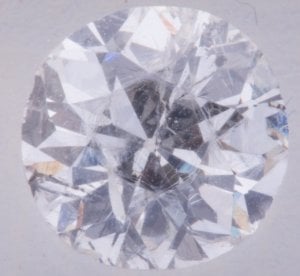dianabarbara
Shiny_Rock
- Joined
- Oct 1, 2012
- Messages
- 464
As some of you know, I have been considering the purchase of a low clarity diamond, for various reasons. The first being, it is a stunning stone. A few weeks ago, I have seen the stone in person and found it really beautiful, very very lively. Of course I could see the inclusions upclose, but it was still very brilliant and attractive. The second being, it is really cheap for its size.
I have done my thinking and decided I do want a large included stone. No concerns on this.
However, after reading more about inclusions and watching the picture again, I started doubting whether some of these inclusions are actually cracks (or feathers).. The one in the center really looks like a crack to me, and I am wondering about the two parallel inclusions on the low left side. Moreover, since they are parallel to each other, I am worried these could be cleavage planes. Looking at the stone from the side, it looks like these imperfections point towards the culet rather than the table, moving from the girdle to the center of the stone.
Please ignore the thin white lines all around the table. These are scratches in the plastic case in which the stone was stored when the picture was taken.
The stone has been graded by a local independent lab as an I1 - how precise this is, I do not know.
Do these look like carbon inclusions or crystals, or do they look like feathers and cracks?
How dangerous would the setting process be, if I decide to go with a bezel to protect the stone during normal wear?
I am having trouble trying to find a proper appraiser in the city I have to purchase the stone, but I will take it to another professional (albeit of less recognized qualification as compared with many on this board). So any feedback would be very appreciated!

I have done my thinking and decided I do want a large included stone. No concerns on this.
However, after reading more about inclusions and watching the picture again, I started doubting whether some of these inclusions are actually cracks (or feathers).. The one in the center really looks like a crack to me, and I am wondering about the two parallel inclusions on the low left side. Moreover, since they are parallel to each other, I am worried these could be cleavage planes. Looking at the stone from the side, it looks like these imperfections point towards the culet rather than the table, moving from the girdle to the center of the stone.
Please ignore the thin white lines all around the table. These are scratches in the plastic case in which the stone was stored when the picture was taken.
The stone has been graded by a local independent lab as an I1 - how precise this is, I do not know.
Do these look like carbon inclusions or crystals, or do they look like feathers and cracks?
How dangerous would the setting process be, if I decide to go with a bezel to protect the stone during normal wear?
I am having trouble trying to find a proper appraiser in the city I have to purchase the stone, but I will take it to another professional (albeit of less recognized qualification as compared with many on this board). So any feedback would be very appreciated!




300x240.png)